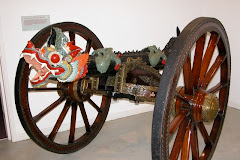It was therefore important to be able to set this angle on the gun. Their solution was the gunner's quadrant. This simple device had an arm that went into the barrel, a quarter circle (quadrant) measuring instrument and a plumb bob. As the gun elevated, so the plumb bob's string moved on the quadrant, allowing the gunner to read the angle.
Over time, of course, this device became gradually more sophisticated, acquiring a levelling bubble to replace the plumb bob and achieving very high accuracy by the means of precision engineering. However, in essence, that is all that a gunner's quadrant is - a means of measuring the angle of elevation of a gun's barrel.





The picture is a good illustration of it.
ReplyDeleteNot sure I would want to fire the gun in that
ReplyDeletesetting.